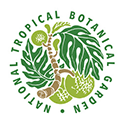Ethnobotany is the study of plants and their uses by people. Breadfruit has been a nutritional and cultural staple food for Pacific Islanders for thousands of years. By studying the relationship between people and breadfruit trees, we learn more about traditional knowledge and customs, and how breadfruit is used for food, agroforestry, medicine, building materials, and more. The importation of other starches such as rice, wheat, and potatoes to Pacific Islands began in the 19th and greatly accelerated in the mid-20th century. As imported processed foods became easy to use and popular to eat, cultivation and consumption of breadfruit drastically declined. Traditional horticultural practices, cooking and preservation methods that had been passed from generation to generation suddenly found a younger population with little interest in breadfruit.
The Breadfruit Institute studied, photographed, videotaped and interviewed Pacific Islanders about traditional and cultural practices to preserve and record this crucial knowledge. Since the turn of the 21st century, devastating storms, drought, and greater environmental education about sustainability and food insecurity have seen a new resurgence in planting breadfruit in the Pacific Islands and other tropical countries, a revitalization of traditional methods, and a revolution in new products and industries.
Samoa
Breadfruit is an important subsistence food crop in Samoa and trees are grown around residences in all villages and in the towns. In 1989 an agricultural census estimated that 89 percent of agricultural households grew breadfruit. Ethnobotanical studies were undertaken in Upolu and Savai’i islands, Samoa, and Tutuila, Ofu, Olosega, and Ta’u in American Samoa to document and compare knowledge of breadfruit names. A total of 354 people comprised of a wide range of ages in both rural villages and towns were interviewed. Forty-six breadfruit variety names were recorded. Subsequent studies concentrated on interviewing knowledgeable villagers to document cultural uses, conservation status, and other information about breadfruit varieties.
Micronesia
Our work has focused on the islands of Pohnpei and Kosrae, Federated States of Micronesia, documenting traditional agroforestry systems and horticultural techniques, food preparation, storage methods and other cultural practices involving breadfruit. Since breadfruit is a seasonal crop that produces much more than can be consumed fresh, Pacific islanders developed innovative techniques to utilize large harvests and store fruit for future use. The most widespread method is fermenting breadfruit in a leaf-lined pit. This process reduces the fruit to a tart doughy paste, which supplements and enhances the daily diet of fresh breadfruit. Fermented breadfruit can last for a year or more. It is removed and eaten at various stages of fermentation depending upon cultural rituals, need, and taste preferences. Fermented breadfruit, called ‘mahr’, ‘furo’, or ‘bwiru’, is still made every season throughout Micronesia. This once common practice has mainly disappeared elsewhere in the Pacific islands.
